by Adela Lovric // Aug. 31, 2022
This article is part of our feature topic ‘SLOW.’
Curated by Lucia Pietroiusti and Filipa Ramos, the eighth edition of Biennale Gherdëina in Val Gardena offers a four-month program celebrating the richness of life that populates the Alps and honoring the complexity of our world beyond the anthropocentric view. The artworks and projects featured in exhibition spaces and embedded in the spectacular landscape of Italy’s Dolomite Mountains echo the biennial’s meditative mantra of “inhale and exhale,” which prompts the visitors to slow down and be more attentive to their bodies and immediate surroundings. Among such art pieces is ‘SENTIERO’ (2022), Alex Cecchetti’s latest walk-based project curated by Valerio Del Baglivo that brings together ecological mindfulness and more-than-human poetry.
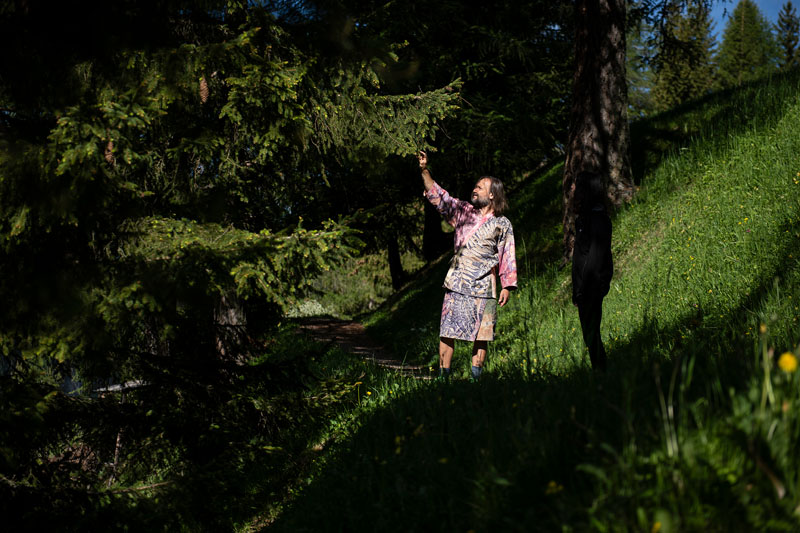
Alex Cecchetti: ‘SENTIERO,’ 2022, Incantation, walk, natural print, yurt, poems, Project curator: Valerio del Baglivo. Project supported by the Italian Council (10th edition, 2021) // Photo by Luca Meneghel
Fully immersive, physically and spiritually intense, ‘SENTIERO’ can last up to several hours. It consists of mountain hikes accompanied by guides—‘sorcerers,’ as Cecchetti calls them—trained by the artist to inspire an interactive contact with the environment. With the help of their enchanted storytelling and exploration of off-the-path routes, visitors are encouraged to appreciate non-human agents and forms of intelligence. The journey ends at a place of shelter called ’YURTA’—a construction inspired by yurts of Mongolian and Afghan nomadic populations, painted with natural dyes and filled with locally sourced dried plants. There, visitors receive a meal and incense, both made of mountain herbs, as the final offering from their guides that completes the multi-sensory experience.
The ongoing Biennale Gherdëina is the first of several contexts in which ‘SENTIERO’ will be presented. We spoke with the Paris- and London-based artist, poet and choreographer to learn more about this project that can be experienced in the unique setting of the Dolomites, a Unesco World Heritage Site, until September 25th.
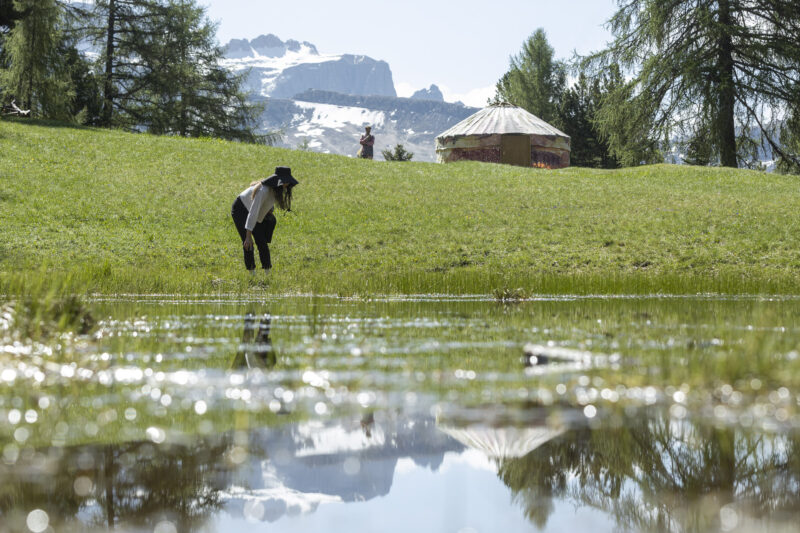
Alex Cecchetti: ‘SENTIERO,’ 2022, Incantation, walk, natural print, yurt, poems, Project curator: Valerio del Baglivo. Project supported by the Italian Council (10th edition, 2021) // Photo by Tiberio Sorvill
Adela Lovric: Art can be considered one of the rare domains where slowness is allowed to exist in a world that demands the opposite. What does the (counter)act of slowing down mean to you—in life, art and your own practice?
Alex Cecchetti: In 2020 and 2021, I spent nine months on Kastellorizo, a little Greek island near Turkey. Due to the lockdown and border restrictions imposed by Covid-19 regulations, it was inhabited by less than 300 people—no tourists, no visitors. Almost every day I was exploring the island, hiking in the dry rocky mountains from dawn to dusk. Every walk had the same rhythm. At the beginning, I was full of worries and anxieties and things were haunting me from faraway Paris: friends, career, projects. Voices in my head were spinning the same old symphony of “you should do this, you should do that.” But once I reached the top of the mountain, tired and silenced by the wind, I experienced a strong and vital feeling of peace. The truth is that my net of relations had changed. Instead of relating to my work, the art world, the people in Paris or Rome, I was instead interlacing my feelings and my existence with other beings, with the two hawks hunting swallows, with the goats feeding on bushes of thorns, with the ancient olive trees and their calm shadows, with the wind and the sun hitting my skin. It wasn’t a matter of fast life against slow life, but of being connected to a different community of beings, larger and more differentiated than the one I had in the city.
I realized that our identities are created with others and can always be rearranged depending on where and with whom we are. When you sit under a tree, you start to think very differently than in an office or a studio, and this is because we don’t think in our head alone, we always think together with whatever is around us.
Our cities are made for humans and inhabited only by humans, and this is true also for our devices, books, movies, social media and jobs—they are all ‘mirror images’ of our idea of being humans. They are not faster or slower, they are instead circular and claustrophobic images. But on top of that mountain in Greece, my image was the myrtle and the carob tree, my reflection was the hawk flying, my books were the waves and the current of the sea.
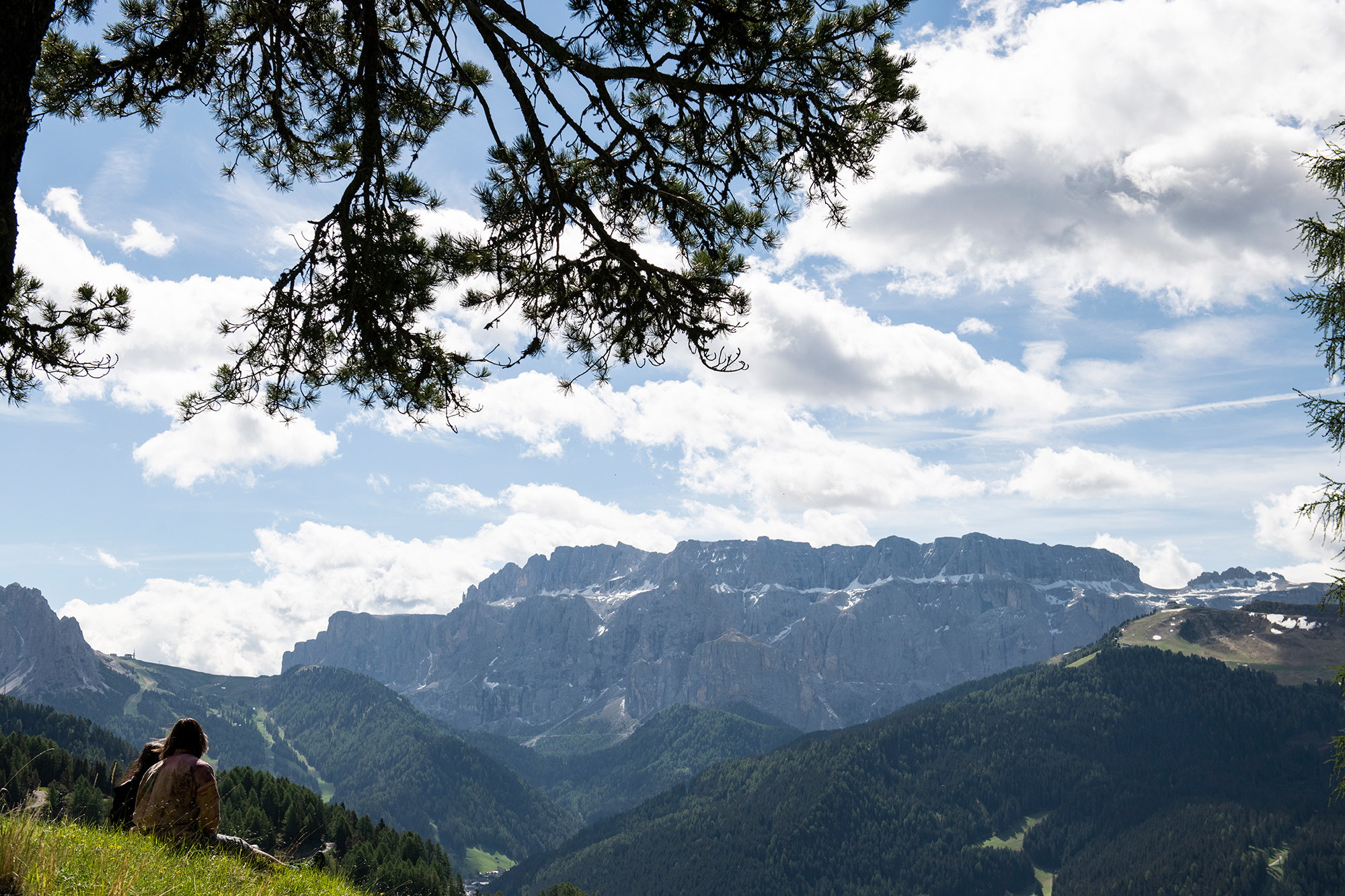
Alex Cecchetti: ‘SENTIERO,’ 2022, Incantation, walk, natural print, yurt, poems, Project curator: Valerio del Baglivo. Project supported by the Italian Council (10th edition, 2021) // Photo by Luca Meneghel
AL: At the Biennale Gherdëina, you’re currently presenting ‘SENTIERO,’ a walk-based project that invites the audience to a long hike in the Dolomites accompanied by a guide. What is this performance really about?
AC: I wanted ‘SENTIERO’ to be a vehicle for a spiritual experience: an incantation, a poem as long as a walk, a walk that makes you tired, a fatigue that opens your heart so much that the inside becomes the outside until you are no longer in yourself.
Humans are nature. We are entangled with everyone else on this planet. Trees, especially plankton, oceanic bacteria and algae give us oxygen. The ocean gives us water; clouds and mountains make it drinkable for us. Bacteria live in our guts and help us think, feel and eat. And if you think that aerobic life on this planet is the result of a connection between the sun and plants, then we are also connected astronomically. There is no end to these connections. In fact, we are not entangled, we are the entanglement. We are not connected to the world, we are just a bunch of world’s connections, all of us. This boundless feeling is what I want to share with the people who walk with us. We will walk until we can no longer identify with our jobs or our family roles, until we forget even our names. Only then, once our little identity is lost, we’ll recognize ourselves in the trees and the rocks and in the flight of the sparrow. We will look around and everywhere we glance, we’ll see a piece of us, the wired and boundless life. There are no borders for the self, only the walls you build around the “I.”
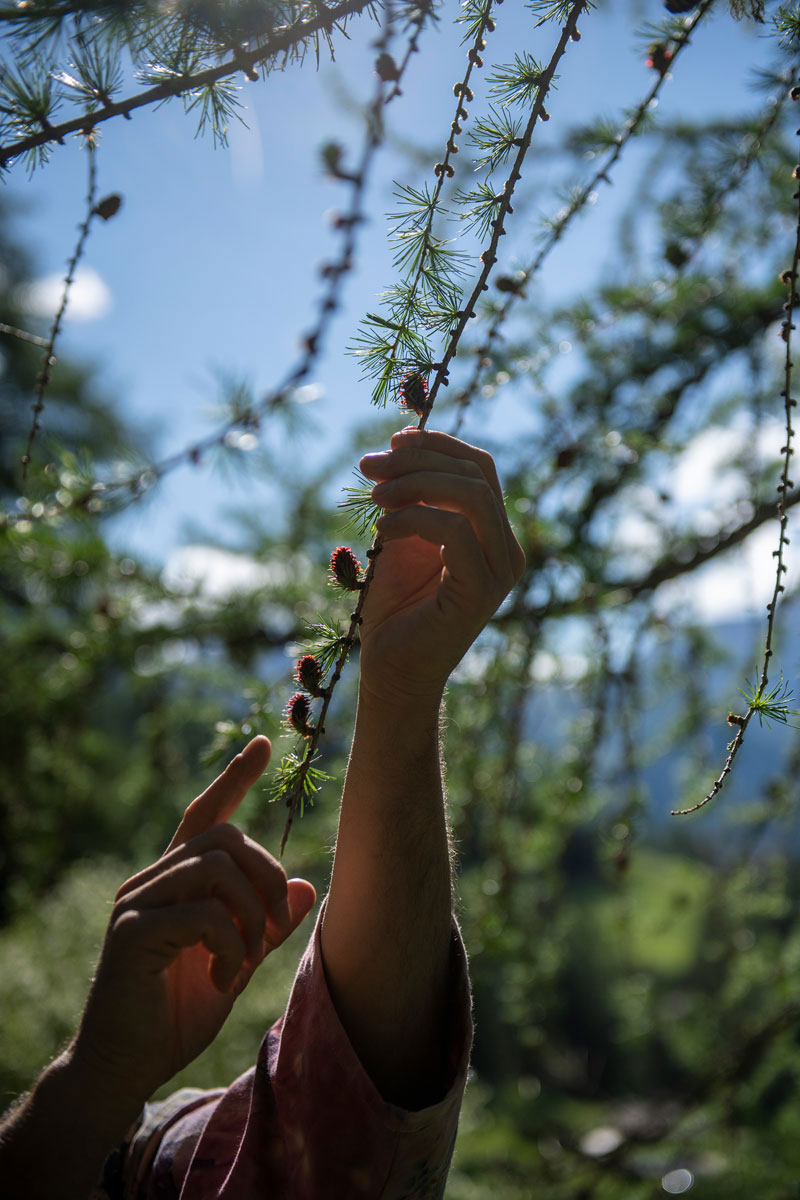
Alex Cecchetti: ‘SENTIERO,’ 2022, Incantation, walk, natural print, yurt, poems, Project curator: Valerio del Baglivo. Project supported by the Italian Council (10th edition, 2021) // Photo by Luca Meneghel
AL: ‘SENTIERO’ is very much tied to its location, the Dolomites. Can you share more details about this interconnectedness?
AC: The Dolomites are very special formations. They are mountains and at the same time they are islands and they were once corals, animals and bones. You may have heard that these mountains were once submerged in an ocean, but the ocean was never here in Italy. These mountains have been formed in a faraway tropical ocean, by the sediments of rivers and organic materials like fish and corals that never lived in Val Gardena. Even rocks and mountains travel, and the Dolomites traveled a long way and still move one millimeter every once in a while. They are pilgrims with no final destination. One day, these mountains may become just little pebbles on a beach.
With ‘SENTIERO,’ I wanted to write a very special love letter to existence and I was struggling with the words until I started to walk these mountains. Once I left the main path in the woods, I realized that that love letter had already been written millions of years ago, and it is rewritten every day; it is whispered by every leaf, every butterfly. I only had to read it, maybe help write it and join the choir. The stories I tell are the stories of the plants, trees, the singing of creeks, the light of the dusk on the top of the mountains. In this sense, it is very local and also, I hope, very universal.
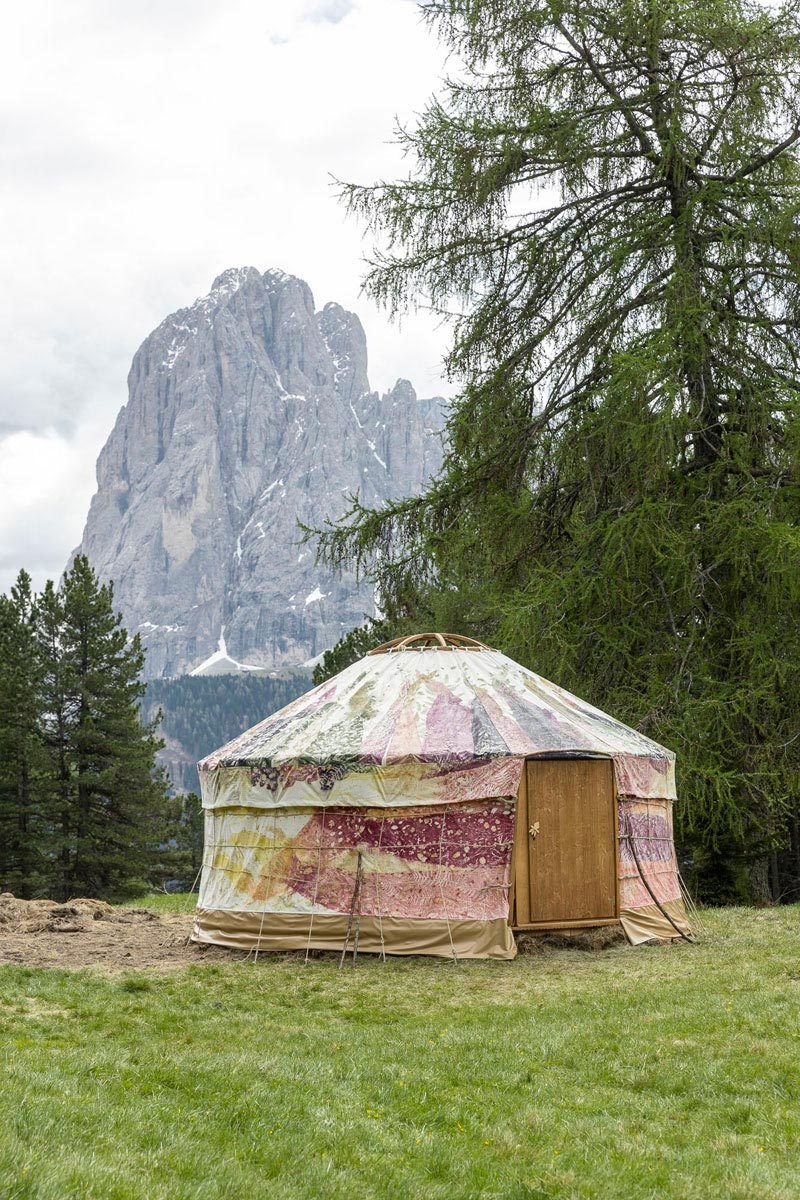
Alex Cecchetti: ‘SENTIERO,’ 2022, Incantation, walk, natural print, yurt, poems, Project curator: Valerio del Baglivo. Project supported by the Italian Council (10th edition, 2021) // Photo by Tiberio Sorvillo
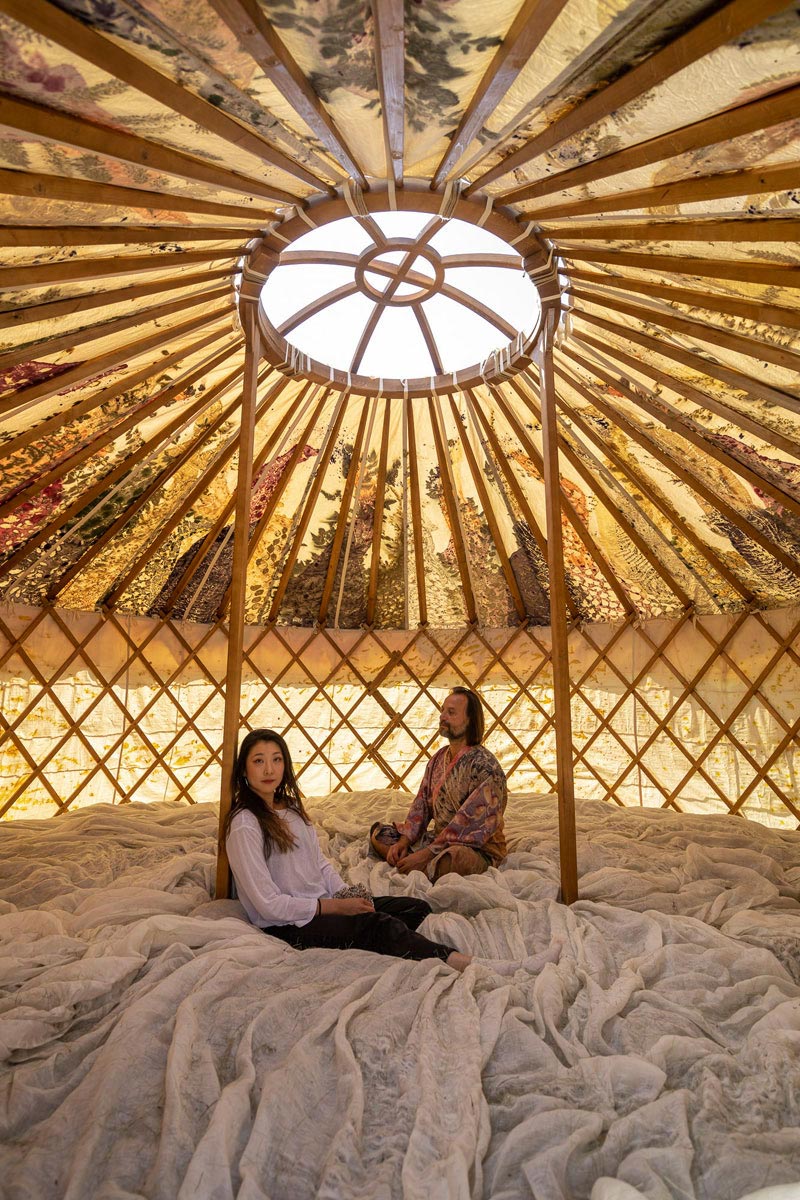
Alex Cecchetti: ‘SENTIERO,’ 2022, Incantation, walk, natural print, yurt, poems, Project curator: Valerio del Baglivo. Project supported by the Italian Council (10th edition, 2021) // Photo by Tiberio Sorvillo
‘SENTIERO’ is also a concert of collaborations—with the land, the plants that helped paint our Kimonos and our Yurt, but also with the people here. Like a forest, we tried to create a net for dialogue and exchange. Franz Mulser, a young chef from the Dolomites, prepared a soup made of all the plants we could meet along the path. Laura dall’Erba gave her decennial experience about natural dying. The people of the village of Santa Cristina gave us their hospitality. With Curdin Tones, we made incense from the perfumes of the woods. And of course—the guides, my sorcerers, gave their voices, bodies and emotions to these stories and songs. The sun did the rest.
AL: How can the ritual of walking in nature as an artistic incantation resist technology- and economy-imposed acceleration we’re experiencing?
AC: Switch off your phone, shut down your laptop and come on a walk with me, or better, alone. I think this is the easiest way. I try not to think in terms of duality as if technology is opposed to nature, or walking is opposed to acceleration. The human body is one of the best technological devices for consciousness. Great architects can be found in species of birds, and anthills are extraordinarily busy cities that seem to never sleep.
Among those who practice deep meditation, there is a general unspoken agreement to never talk about what is experienced during the most intense sessions. This silence is not intended to create mystery or mystification, but is instead an effort to not influence other people’s personal experiences. The spiritual awakening has an infinite amount of faces, not one of which is definitive. What is important is to stick to the practice of meditation, or walking, like a lover who constantly writes love letters.
Exhibition Info
Biennale Gherdëina
Biennale Gherdëina ∞: ‘Persones Persons’
Exhibition: May 20–Sept. 25, 2022
biennalegherdeina.it
Various venues in Val Gardena, Dolomites, click here for map























